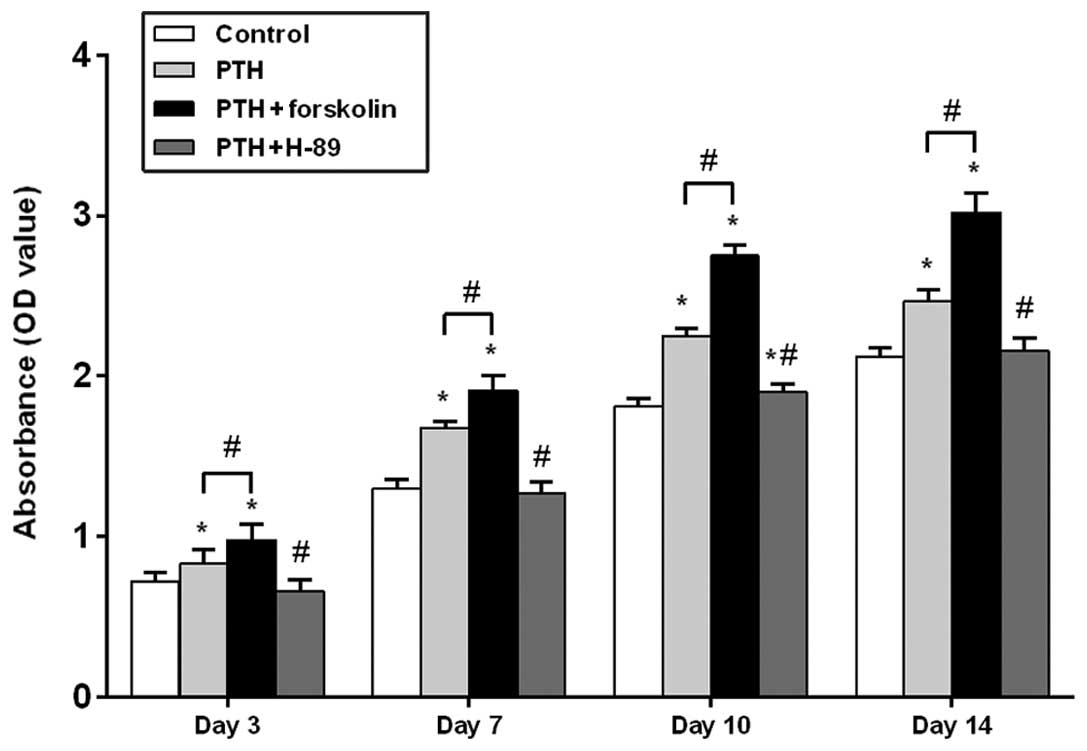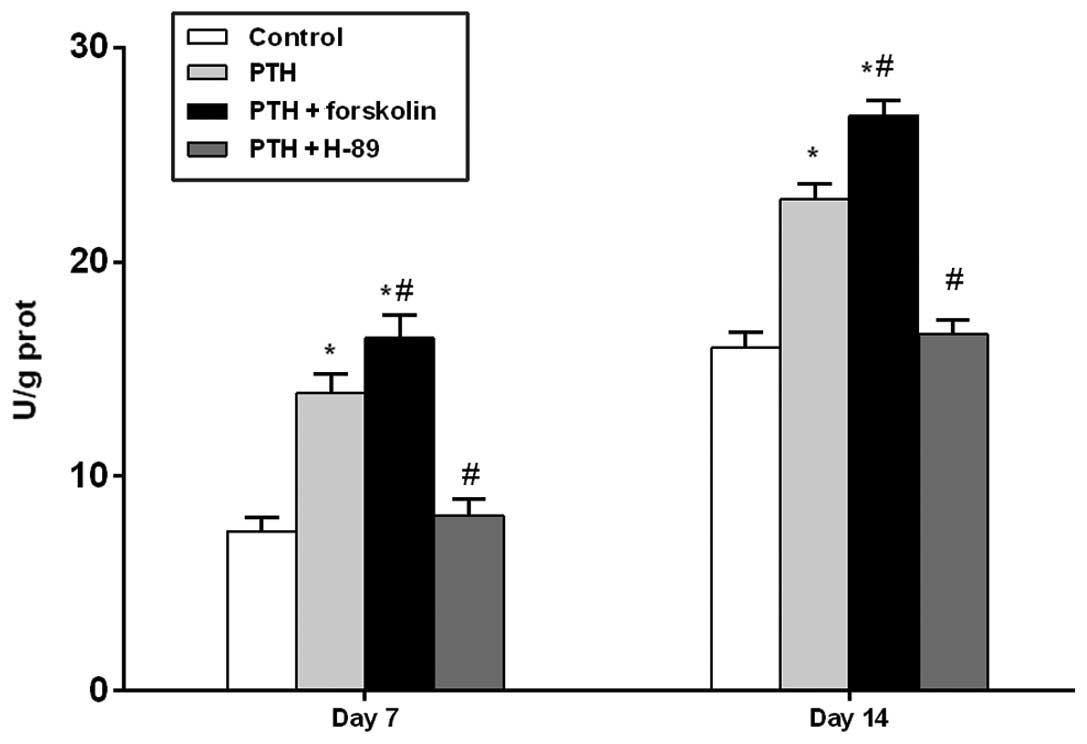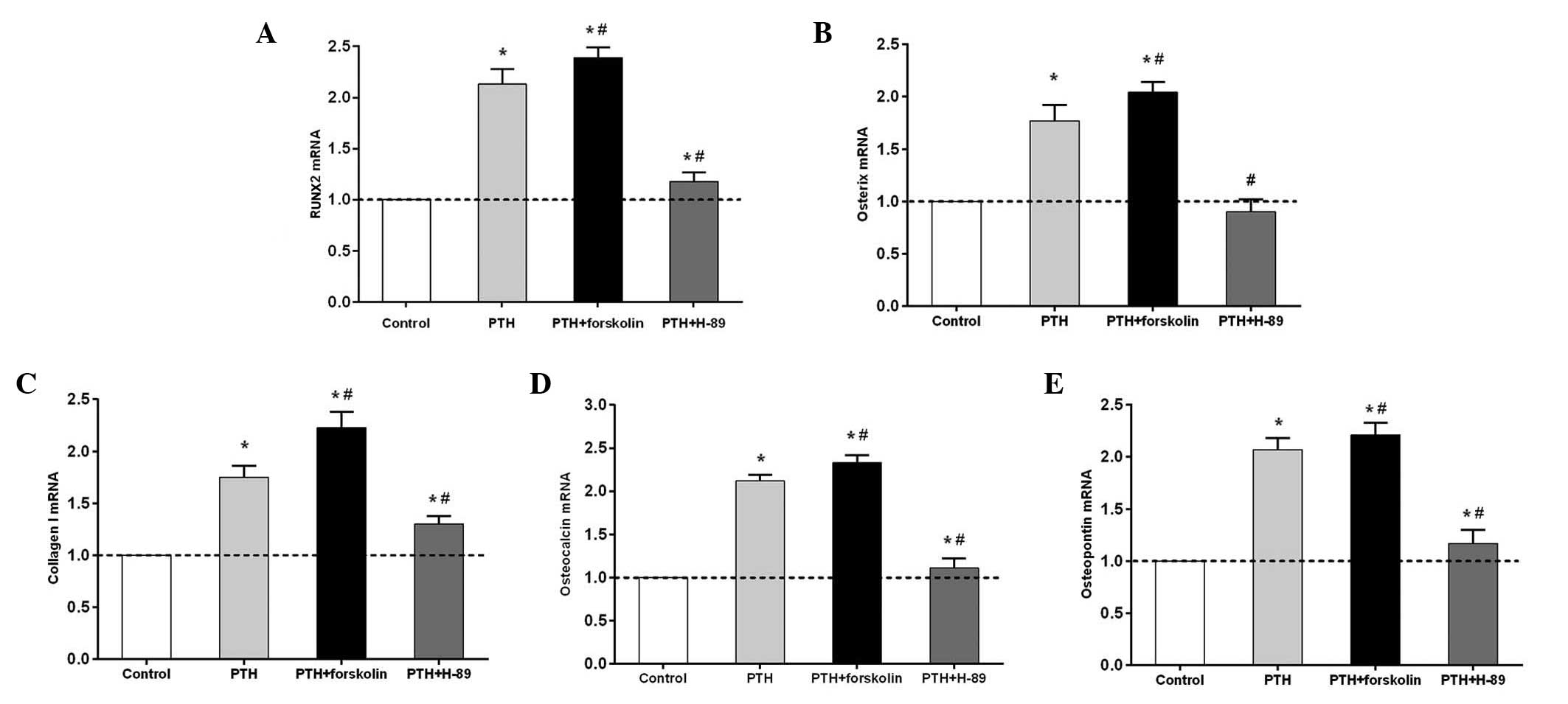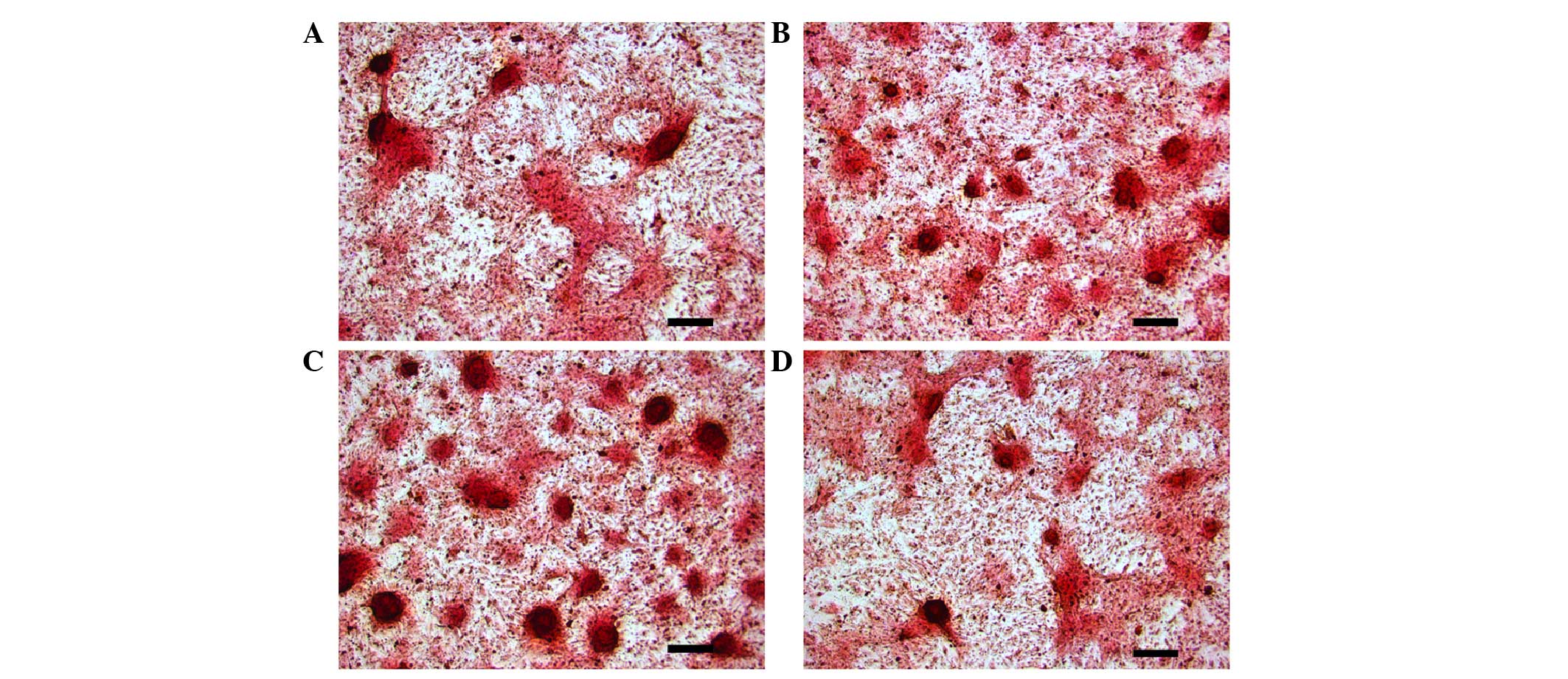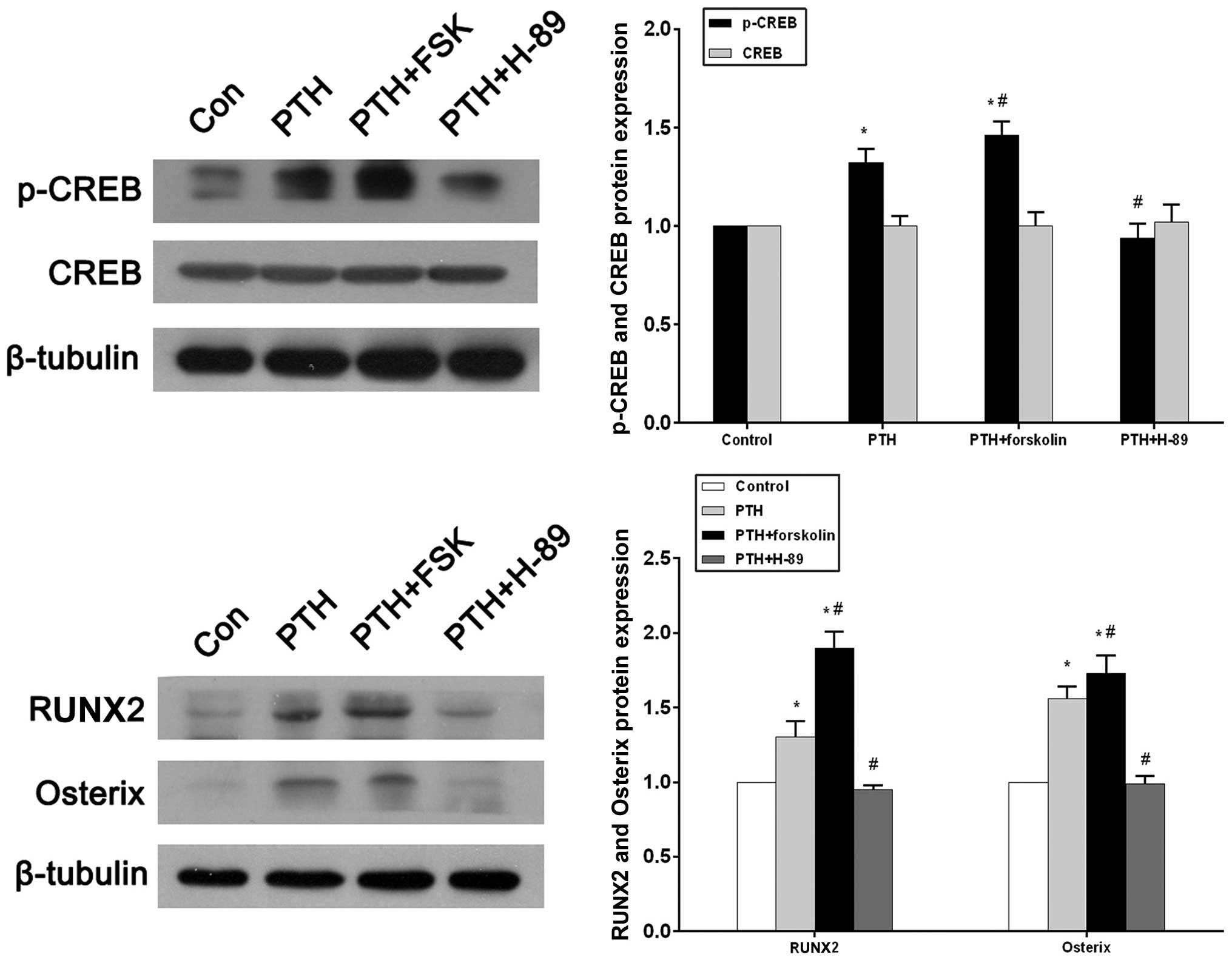Intermittent parathyroid hormone (1-34) application regulates cAMP-response element binding protein activity to promote the proliferation and osteogenic differentiation of bone mesenchymal stromal cells, via the cAMP/PKA signaling pathway
- Authors:
- Published online on: March 22, 2016 https://doi.org/10.3892/etm.2016.3177
- Pages: 2399-2406
Abstract
Introduction
Parathyroid hormone (1–34) [PTH (1–34)] is currently the only anabolic agent approved by the Food and Drug Administration (FDA) for the treatment of osteoporosis in the USA (1). It is established that intermittent PTH (1–34) administration increases mass, strength and mineral density of bone, and improves bone microarchitecture and fracture healing (2–4). Furthermore, previous in vitro studies have indicated that intermittent delivery of PTH (1–34) enhances the proliferation and differentiation of osteoprogenitor cells in bone marrow, increases osteoblast activity and inhibits osteoblast apoptosis (5–7). However, the precise molecular mechanism underlying the effect of PTH (1–34) during the osteogenic differentiation of bone mesenchymal stromal cells (BMSCs) remains elusive.
A number of previous studies have reported that PTH affects osteoblastic cells through activation of cyclic adenosine monophosphate/protein kinase A (cAMP/PKA) (8,9), Wnt/β-catenin (10–12) and mitogen-activated protein kinase signaling pathways (13,14); however, the focus of previous studies has particularly been on cAMP signaling. Several previous studies have evaluated the role of PKA pathway in osteogenic differentiation of hMSCs, and reported that pretreatment of human MSCs with a cAMP analog or forskolin enhanced bone formation (15–17). cAMP is a pivotal intracellular signaling molecule, the main function of which is to activate the cAMP-dependent PKA (18). Adenylate cyclase is activated through dissociated G-proteins, causing the conversion of adenosine triphosphate into cAMP (17). Subsequently, cAMP activates PKA, the cAMP-responsive element binding (CREB) protein is phosphorylated, and this translocates into the nucleus where it activates transcription of target genes (17).
PTH signaling is mediated by a G protein-coupled receptor, known as parathyroid receptor 1 (PTHR1) (19). Ligand binding to PTHR1 stimulates the activation of adenylate cyclase mediated by the G protein subunit Gαs, thereby stimulating cAMP production and the subsequent activation of PKA. Wang et al (8) treated the rat osteoblast-like cell line UMR 106 with PTH (1–34), revealing that PTH stimulates the expression of the transcription factors runt related transcription factor 2 (RUNX2) and osterix in vitro, and that induction of RUNX2 mRNA expression is mediated through the activation of the cAMP/PKA pathway. In another study, Nakao et al (9) evaluated cAMP and bone morphogenetic protein (BMP) levels in MC3T3-E1 cells following the addition of PTH, and found that PTH enhanced BMP activity by increasing cAMP accumulation in MC3T3-E1 cells.
Although a number of previous studies have demonstrated that the effects of PTH (1–34) are associated with the cAMP/PKA pathway, it is unclear how intermittent administration of PTH (1–34) regulates osteogenic differentiation of BMSCs through the cAMP/PKA pathway. The present study therefore aimed to investigate the molecular mechanism of intermittent PTH (1–34) application in the regulation of the proliferation and osteogenic differentiation of BMSCs by the cAMP/PKA pathway.
Materials and methods
Isolation and culture of rat BMSCs
A total of 20 male Sprague-Dawley rats (age, 5 weeks; weight, 100–120 g) were purchased from the Experimental Animal Center of Sun Yat-Sen University (Guangzhou, China) for use in the present study. The rats were acclimated to the housing conditions for 7 days, during which the rats were maintained under a 12-h light/dark cycle at 22°C with ad libitum access to food and water. The current study was approved by the Animal Care Committee of Sun Yat-Sen University and was in compliance with guiding principles for the use of laboratory animals (20). Following sacrifice of the rats by overdose with 10% chloral hydrate (intraperitoneal injection; Guangzhou Chemical Reagent Factory, Guangzhou, China), the femora and tibiae of the rats were removed. The ends of each bone were dissected and the BMSCs were harvested by flushing out the bone marrow with 5 ml Dulbecco's modified Eagle's medium (DMEM; Gibco; Thermo Fisher Scientific, Inc., Waltham, MA, USA) twice using a syringe. The BMSCs were centrifuged at 1,000 × g for 5 min, resuspended in DMEM containing 10% fetal bovine serum (FBS; Gibco; Thermo Fisher Scientific, Inc.) and 1% penicillin/streptomycin (Gibco; Thermo Fisher Scientific, Inc.) and incubated at 37°C with 5% CO2. The culture medium was changed every 2 days. Upon reaching 80–90% confluence, the cells were subcultured. BMSCs at passage 3 were used in all experiments.
PTH (1–34), forskolin and H-89 administration
For all experiments, BMSCs were randomly divided into four groups, as follows: No PTH treatment (control); PTH (1–34) treatment (PTH; ProSpec-Tany TecnoGene Ltd., Rehovot, Israel); PTH (1–34) plus treatment with forskolin (FSK; Beyotime Institute of Biotechnology, Haimen, China), an adenylyl cyclase activator; and PTH (1–34) plus treatment with a PKA inhibitor (H-89; Beyotime Institute of Biotechnology).
For the control group, 24 h after culture, the medium was changed to fresh DMEM medium for 6 h, and then the cells were cultured in PTH-free osteogenic medium containing 10 nM dexamethasone, 10 mM β-glycerophosphate, and 50 µg/ml ascorbic acid, (all Sigma-Aldrich, St. Louis, MO, USA) for the remaining 42 h of each 48-h cycle. In the PTH group, BMSCs were exposed to 10 nM PTH (1–34) (7) in DMEM medium for the first 6 h of each 48-h cycle and then washed with phosphate-buffered saline (PBS) and cultured in osteogenic medium for the subsequent 42 h. Similarly, BMSCs in the FSK and H-89 groups were treated for 6 h with 10 nM PTH (1–34) plus 10 nM forskolin or 10 µM H-89 (21), respectively, before being washed with PBS and cultured in osteogenic medium for 42 h. In all groups, the medium was changed every 48 h, and all groups were cultured for 14 days.
Cell proliferation assay
BMSCs were cultured in 96-well plates at a density of 1×103 cells/well, and treated as described above. Cell proliferation was assessed using a Cell Counting kit-8 (CCK-8; Dojindo Molecular Technologies, Inc., Kumamoto, Japan) at 3,7,10 and 14 days. For this, the culture medium in all groups was removed and changed to fresh culture medium. Subsequently, CCK-8 solution was added (10 µl per well) and incubated for 2 h at 37°C with 5% CO2. Finally, cell proliferation was assessed on the basis of optical density values, measured at 450 nm using a Sunrise microplate reader (Tecan Trading AG, Männedorf, Switzerland). Five replicates of each sample at each time point were measured.
Alkaline phosphatase (ALP) activity assessment
BMSCs were seeded in 6-well plates at a density of 5×104 cells/well in each group and treated as described above. On days 7 and 14, ALP was extracted and detected using a SensoLyte p-nitrophenyl phosphate (pNPP) ALP assay kit (AnaSpec, Inc., Fremont, CA, USA) in accordance with the manufacturer's protocol. Cells were initially lysed using radioimmunoprecipitation assay lysis buffer (Beyotime Institute of Biotechnology), containing 10 mM Tris (pH 7.0), 1 mM EDTA, and 0.2% Triton X-100, and the lysates were frozen at −80°C and then thawed. Cell lysate was centrifuged for 15 min (10,000 × g, 4°C), after which the supernatant was collected and combined with pNPP. ALP activity was determined at 405 nm using the Sunrise microplate reader. The values were normalized to total protein content, measured using a NanoDrop 2000 spectrophotometer (NanoDrop; Thermo Fisher Scientific, Inc., Wilmington, DE, USA).
Reverse transcription-quantitative polymerase chain reaction (RT-qPCR)
On day 14, total RNA was extracted from the cultured cells in each group using TRIzol (Invitrogen; Thermo Fisher Scientific, Inc.). Subsequent to RNA isolation, the concentration and purity of RNA was assessed using a NanoDrop 2000 spectrophotometer. A total of 1,000 ng RNA per group was used for cDNA synthesis using a SYBR-PrimeScript RT-PCR kit (Takara Biotechnology Co., Ltd., Dalian, China). This included 0.5 µl PrimeScript RT Enzyme mix I, 0.5 ml oligo dT primer, and 2 ml PrimeScript Buffer to a final volume of 10 µl. A total of 1 µl cDNA was then used for RT-qPCR in a 10-µl reaction volume containing 0.3 µl forward and 0.3 µl reverse primers (Table I), 5 µl SYBR Premix Ex Taq (Takara Biotechnology Co., Ltd.) and 3.4 µl diethylpyrocarbonate-treated water (Takara Biotechnology Co., Ltd.). qPCR was performed on each cDNA sample in triplicate under the following cycling conditions: Initial denaturation at 95°C for 5 min, followed by 40 cycles of denaturation at 94°C for 30 sec, annealing at 60°C for 10 sec and elongation at 72°C for 20 sec, and a final extension step at 72°C for 10 min. Fluorescence data was analyzed using a CFX96 Real-Time PCR Detection system (Bio-Rad Laboratories, Inc., Hercules, CA, USA). Gene expression levels were calculated using the 2−∆∆Cq method (22). Data are presented as fold change relative to control samples.
Alizarin Red S staining
To observe the osteogenic differentiation of BMSCs, cells were subjected to Alizarin Red S staining. Cells were seeded in 24-well plates at a density of 5×103 cells/well. Following the 14-day culture, the osteogenic medium was removed from the cells in each group. Cells were then washed twice with ice-cold PBS and fixed with 70% ethanol for 30 min. Next, cells were stained with 1% Alizarin Red S solution (pH 4.2; Sigma-Aldrich) for 15 min and gently rinsed with dH2O. The samples were imaged with an Axio Imager Z1 microscope (Zeiss AG, Oberkochen, Germany).
Western blot analysis
Following the 14-day culture, cells in each group were washed twice with ice-cold PBS and lysed in 80 µl Mammalian Protein Extraction reagent and protease inhibitor cocktail tablets (both Thermo Fisher Scientific, Inc.). The samples were centrifuged for 15 min (12,000 × g, 4°C), the supernatant was extracted and total protein concentration was determined using a NanoDrop 2000 spectrophotometer. The samples were denatured by heating for 5 min at 95°C in loading buffer (Beyotime Institute of Biotechnology), containing 0.5 M Tris·HCl, 0.5 M DTT, sodium dodecyl sulfate (SDS), bromophenol blue and glycerol. Subsequently, equal volumes of the samples (20 µl) were run on 12% SDS-polyacrylamide gels and transferred to polyvinylidene fluoride membranes. The membranes were blocked for 1 h with blocking reagent (Tris-buffered saline containing 5% nonfat milk powder) and incubated overnight at 4°C with primary antibodies, as follows: Rabbit anti-phosphorylated CREB (p-CREB) monoclonal antibody (mAb; 1:1,000; cat. no. 9198), rabbit anti-CREB mAb (1:1,000; cat. no. 9197), rabbit anti-RUNX2 mAb (1:1,000; cat. no. 12556), rabbit anti-osterix mAb (1:1,000; cat. no. 13572) and rabbit anti-β-tubulin mAb (1:1,000; #15115; all Cell Signaling Technology, Inc., Danvers, MA, USA). The membrane was then incubated with alkaline phosphatase-conjugated goat anti-IgG (1:2,000, cat. no. 7054; Cell Signaling Technology) for 1 h at room temperature, and the proteins were visualized using a chemiluminescence kit (EMD Millipore, Billerica, MA, USA). Densitometric analysis was performed using Photoshop CS5 (Adobe Systems, Inc., San Jose, CA, USA).
Statistical analysis
All results are expressed as the mean ± standard deviation. Comparative studies of means were performed by one-way analysis of variance and Fisher's least significant difference test, using SPSS version 13.0 (SPSS, Inc., Chicago, IL, USA) and a statistically significant difference was defined as P<0.05. All experiments were repeated in triplicate.
Results
Intermittent PTH (1–34) administration regulates proliferation of BMSCs via the cAMP/PKA pathway
As shown in Fig. 1, the cell number, as determined by the optical density using a cell counting kit, gradually increased over time in all four groups. After 3, 7, 10 and 14 days of intermittent PTH (1–34) treatment, an increase in cell number was observed in the PTH group compared with the control group, and there was a significant difference between these groups at each time point (P<0.05). In the PTH + FSK group, a significant increase in cell number was observed on days 3, 7, 10 and 14 when compared with the control group (P<0.05) and with the PTH group (P<0.05). Following treatment of PTH (1–34) plus H-89, cell number was significantly decreased compared with that in the PTH group at each time point (P<0.05). No significant difference was observed between the PTH + H-89 group and the control groups on days 3, 7 and 14 (P>0.05), but on day 10 an increase in cell number was observed in the TH + H-89 group compared with the control group (P<0.05).
Assessment of ALP activity under different treatment conditions
At days 7 and 14, the PTH and PTH + FSK groups demonstrated significantly increased ALP activity compared with the control group (P<0.05), and the PTH + FSK group also had significantly increased ALP activity compared with the PTH group (P<0.05). However, treatment with H-89 reduced ALP activity compared with that in the PTH group (P<0.05; Fig. 2).
Intermittent PTH (1–34) administration promotes osteogenic gene expression via the cAMP/PKA signaling pathway
RUNX2, osterix, collagen I, osteocalcin and osteopontin mRNA expression levels in the PTH and PTH + FSK groups significantly increased compared with those in the control group (P<0.05), but the levels of all genes examined were higher in the PTH + FSK group than in the PTH group (P<0.05; Fig. 3). RUNX2, osterix, collagen I, osteocalcin and osteopontin mRNA expression was significantly downregulated in the PTH + H-89 group compared with the PTH group (P<0.05), but the mRNA expression levels of these (with the exception of osterix) were higher in the PTH + H-89 group than in the control group (P<0.05). Notably, osterix mRNA expression revealed a moderate but not statistically significant reduction in the PTH + H-89 group compared with the control group.
Effects of intermittent PTH (1–34) application on mineralization of osteoblasts, induced from BMSCs via the cAMP/PKA pathway
As indicated in Fig. 4, the PTH and PTH + FSK groups developed notably increased mineralization compared with the control group (Fig. 4A–C). The mineralization effect of PTH (1–34) plus forskolin was markedly increased from that of PTH (1–34) treatment alone. However, treatment with PTH (1–34) plus H-89 reduced mineralization compared with that in the PTH group (Fig. 4B and D).
Intermittent PTH (1–34) treatment increases osteogenic differentiation of BMSCs, mediated by the cAMP/PKA signaling pathway
Western blotting and a densitometric analysis revealed that p-CREB expression in the PTH group increased significantly compared with that in the control group (P<0.05; Fig. 5A). With the concurrent administration of forskolin, p-CREB expression markedly increased compared with that in the control group (P<0.05) and the PTH group (P<0.05). In the PTH + H-89 group, p-CREB expression was reduced compared with that in the PTH group (P<0.05), and did not significantly differ from the p-CREB expression in the control group (P>0.05; Fig. 5A). Conversely, there were no statistical differences in CREB expression between the four groups. (P>0.05; Fig. 5A). RUNX2 and osterix protein levels were significantly increased in the PTH and PTH + FSK groups when compared with the control group (P<0.05), and the FSK group also exhibited increased expression of these proteins compared with the PTH group (P<0.05). Significant reductions in RUNX2 and osterix protein expression levels were observed in the PTH + H-89 group compared with the PTH group (P<0.05), but a difference was not observed compared with the control group (Fig. 5B).
Discussion
Previous studies have demonstrated the anabolic effect of intermittent PTH (1–34) on bone formation (23,24). Furthermore, a number of studies have suggested that cAMP/PKA signaling is activated by PTH (1–34) during osteogenic differentiation (8,9,21). However, precisely how the intermittent administration of PTH (1–34) regulates osteogenic differentiation of BMSCs via the cAMP/PKA signaling pathway requires elucidation. In the present study, the adenylyl cyclase activator forskolin and the specific PKA inhibitor H-89 were used. A cell proliferation assay, osteogenic gene testing, ALP activity detection, Alizarin Red S staining and detection of p-CREB, RUNX2 and osterix protein expression were used in the current study in order to determine the underlying molecular mechanism by which intermittent PTH (1–34) administration modulates the proliferation and osteogenic differentiation of BMSCs via the cAMP/PKA signaling pathway. The present findings indicated that intermittent PTH (1–34) treatment regulates p-CREB to promote the proliferation and osteogenic differentiation of BMSCs through the cAMP/PKA pathway.
The results of the cell proliferation assay demonstrated that PTH (1–34) stimulated BMSC proliferation, forskolin enhanced PTH-stimulated BMSC proliferation and the stimulating effect of PTH (1–34) was blocked by H-89. The results indicated that intermittent PTH (1–34) treatment promoted proliferation of BMSCs through the cAMP/PKA pathway. Previously, Baron and Hesse (25) had also suggested that PTH stimulated the proliferation of MSCs. Nishida et al (26) cultured bone marrow cells isolated from the femora and tibiae of rats and treated them with PTH, reporting that PTH induced apparent increases in the total number of colony forming unit-fibroblasts. The findings of the present study add to the current body of knowledge about the effects of PTH (1–34) on BMSC proliferation via the cAMP/PKA pathway.
RUNX2 and osterix are transcription factors used in osteogenic lineage commitment expressed specifically at high levels in osteoblasts. Thus, RUNX2 and osterix may be considered to be osteoblast-specific transcription factors (27,28). In support of the current results, Krishnan et al (29) revealed that PTH rapidly increases RUNX2 mRNA and protein levels through activation of the cAMP/PKA pathway and Wang et al (8) demonstrated that PTH stimulates RUNX2 and osterix mRNA expression via cAMP/PKA signaling. Furthermore, ALP is the most widely recognized marker of osteoblast phenotypes and has an important role during bone mineralization (30). A previous study reported that PTH promotes osteogenic differentiation from MSCs by enhancing ALP activity (7). Kao et al (16) reported that treating BMSCs with PTH increased the number of ALP-positive cells, and that activation of cAMP signaling in BMSCs with forskolin markedly enhanced ALP activity. It is also of note that collagen I is a focal component of the extracellular matrix in the bone, and the expression of collagen I typically occurs at the stage of matrix synthesis during osteogenesis (31–33). In addition, expression of osteocalcin and osteopontin mark the onset of mineralization (34). Kao et al (16) reported that direct activation of cAMP signaling by forskolin in BMSCs elevated the expression of osteoblast marker genes, such as RUNX2, osterix, collagen I and osteocalcin, and that treatment of BMSCs with PTH enhanced the ability of the subsequent differentiated osteoblasts to mineralize. As with PTH, exposing BMSCs to forskolin also increased mineralization. In the present study, and consistent with these previous studies, the results of the ALP activity assay and RT-qPCR revealed that ALP activity and RUNX2, osterix, collagen I, osteocalcin and osteopontin expression were all upregulated by intermittent PTH (1–34) application, and that the addition of forskolin enhanced these effects to a greater degree than was achieved by PTH (1–34) alone. Furthermore, the effects of PTH (1–34) were inhibited by H-89. Alizarin Red S staining revealed that intermittent PTH (1–34) treatment significantly increased mineralization via the cAMP/PKA pathway. Together, these data imply that intermittent PTH (1–34) administration can affect osteogenesis by increasing the commitment of BMSCs to the osteogenic lineage, via activation of the cAMP/PKA pathway.
CREB is a cellular transcription factor (35) that is phosphorylated subsequent to cAMP activation of PKA. CREB then translocates into the nucleus, where it activates transcription of target genes (17). Siddappa et al (15) suggested that addition of dibutyryladenosine-cAMP to human MSCs for 6 h resulted in increased phosphorylation of the transcription factor CREB, which could be inhibited by treatment with H-89. Furthermore, Tyson et al (36) cultured UMR 106 cells and treated them with PTH, finding that PKA is the enzyme responsible for phosphorylating CREB in response to PTH. In the current study, the western blot analysis demonstrated that intermittent PTH (1–34) application upregulated the expression of p-CREB, that administration of forskolin significantly increased p-CREB expression in addition to that observed with PTH treatment alone and that the effect of PTH on p-CREB expression could be blocked by H-89. This trend was also observed in the protein expression of RUNX2 and osterix.
In conclusion, the present in vitro study demonstrated that intermittent PTH (1–34) administration regulates the proteins downstream of the cAMP/PKA signaling pathway, such as p-CREB, to enhance the proliferation, osteogenic differentiation and mineralization of BMSCs.
Acknowledgements
This study was supported by the Guangdong Nature Science Foundation in 2013 (grant no. S2013010015784).
References
|
Pettway GJ, Meganck JA, Koh AJ, Keller ET, Goldstein SA and McCauley LK: Parathyroid hormone mediates bone growth through the regulation of osteoblast proliferation and differentiation. Bone. 42:806–818. 2008. View Article : Google Scholar : PubMed/NCBI | |
|
Compston JE: Skeletal actions of intermittent parathyroid hormone: Effects on bone remodelling and structure. Bone. 40:1447–1452. 2007. View Article : Google Scholar : PubMed/NCBI | |
|
Neer RM, Arnaud CD, Zanchetta JR, Prince R, Gaich GA, Reginster JY, Hodsman AB, Eriksen EF, Ish-Shalom S, Genant HK, et al: Effect of parathyroid hormone (1–34) on fractures and bone mineral density in postmenopausal women with osteoporosis. N Engl J Med. 344:1434–1441. 2001. View Article : Google Scholar : PubMed/NCBI | |
|
Jiang Y, Zhao J, Liao EY, Dai RC, Wu XP and Genant HK: Application of micro-CT assessment of 3-D bone microstructure in preclinical and clinical studies. J Bone Miner Metab. 23(Suppl): S122–S131. 2005. View Article : Google Scholar | |
|
Jilka RL, Weinstein RS, Bellido T, Roberson P, Parfitt AM and Manolagas SC: Increased bone formation by prevention of osteoblast apoptosis with parathyroid hormone. J Clin Invest. 104:439–446. 1999. View Article : Google Scholar : PubMed/NCBI | |
|
Kaback LA, do Soung Y, Naik A, Geneau G, Schwarz EM, Rosier RN, O'Keefe RJ and Drissi H: Teriparatide (1–34 human PTH) regulation of osterix during fracture repair. J Cell Biochem. 105:219–226. 2008. View Article : Google Scholar : PubMed/NCBI | |
|
Yang C, Frei H, Burt HM and Rossi F: Effects of continuous and pulsatile PTH treatments on rat bone marrow stromal cells. Biochem Biophys Res Commun. 380:791–796. 2009. View Article : Google Scholar : PubMed/NCBI | |
|
Wang BL, Dai CL, Quan JX, Zhu ZF, Zheng F, Zhang HX, Guo SY, Guo G, Zhang JY and Qiu MC: Parathyroid hormone regulates osterix and Runx2 mRNA expression predominantly through protein kinase A signaling in osteoblast-like cells. J Endocrinol Invest. 29:101–108. 2006. View Article : Google Scholar : PubMed/NCBI | |
|
Nakao Y, Koike T, Ohta Y, Manaka T, Imai Y and Takaoka K: Parathyroid hormone enhances bone morphogenetic protein activity by increasing intracellular 3′,5′-cyclic adenosine monophosphate accumulation in osteoblastic MC3T3-E1 cells. Bone. 44:872–877. 2009. View Article : Google Scholar : PubMed/NCBI | |
|
Kulkarni NH, Halladay DL, Miles RR, Gilbert LM, Frolik CA, Galvin RJ, Martin TJ, Gillespie MT and Onyia JE: Effects of parathyroid hormone on Wnt signaling pathway in bone. J Cell Biochem. 95:1178–1190. 2005. View Article : Google Scholar : PubMed/NCBI | |
|
Inoue Y, Canaff L, Hendy GN, Hisa I, Sugimoto T, Chihara K and Kaji H: Role of Smad3, acting independently of transforming growth factor-beta, in the early induction of Wnt-beta-catenin signaling by parathyroid hormone in mouse osteoblastic cells. J Cell Biochem. 108:285–294. 2009. View Article : Google Scholar : PubMed/NCBI | |
|
Tian Y, Xu Y, Fu Q and He M: Parathyroid hormone regulates osteoblast differentiation in a Wnt/β-catenin-dependent manner. Mol Cell Biochem. 355:211–216. 2011. View Article : Google Scholar : PubMed/NCBI | |
|
Miao D, Tong XK, Chan GK, Panda D, McPherson PS and Goltzman D: Parathyroid hormone-related peptide stimulates osteogenic cell proliferation through protein kinase C activation of the Ras/mitogen-activated protein kinase signaling pathway. J Biol Chem. 276:32204–32213. 2001. View Article : Google Scholar : PubMed/NCBI | |
|
Rey A, Manen D, Rizzoli R, Ferrari SL and Caverzasio J: Evidences for a role of p38 MAP kinase in the stimulation of alkaline phosphatase and matrix mineralization induced by parathyroid hormone in osteoblastic cells. Bone. 41:59–67. 2007. View Article : Google Scholar : PubMed/NCBI | |
|
Siddappa R, Martens A, Doorn J, Leusink A, Olivo C, Licht R, van Rijn L, Gaspar C, Fodde R, Janssen F, et al: cAMP/PKA pathway activation in human mesenchymal stem cells in vitro results in robust bone formation in vivo. Proc Natl Acad Sci USA. 105:7281–7286. 2008. View Article : Google Scholar : PubMed/NCBI | |
|
Kao R, Lu W, Louie A and Nissenson R: Cyclic AMP signaling in bone marrow stromal cells has reciprocal effects on the ability of mesenchymal stem cells to differentiate into mature osteoblasts versus mature adipocytes. Endocrine. 42:622–636. 2012. View Article : Google Scholar : PubMed/NCBI | |
|
Doorn J, Siddappa R, van Blitterswijk CA and de Boer J: Forskolin enhances in vivo bone formation by human mesenchymal stromal cells. Tissue Eng Part A. 18:558–567. 2012. View Article : Google Scholar : PubMed/NCBI | |
|
Yang DC, Tsay HJ, Lin SY, Chiou SH, Li MJ, Chang TJ and Hung SC: cAMP/PKA regulates osteogenesis, adipogenesis and ratio of RANKL/OPG mRNA expression in mesenchymal stem cells by suppressing leptin. PLoS One. 3:e15402008. View Article : Google Scholar : PubMed/NCBI | |
|
Potts JT: Parathyroid hormone: Past and present. J Endocrinol. 187:311–325. 2005. View Article : Google Scholar : PubMed/NCBI | |
|
Zimmermann M: Ethical guidelines for investigations of experimental pain in conscious animals. Pain. 16:109–110. 1983. View Article : Google Scholar : PubMed/NCBI | |
|
Kawane T, Mimura J, Yanagawa T, Fujii-Kuriyama Y and Horiuchi N: Parathyroid hormone (PTH) down-regulates PTH/PTH-related protein receptor gene expression in UMR-106 osteoblast-like cells via a 3′,5′-cyclic adenosine monophosphate-dependent, protein kinase A-independent pathway. J Endocrinol. 178:247–256. 2003. View Article : Google Scholar : PubMed/NCBI | |
|
Livak KJ and Schmittgen TD: Analysis of relative gene expression data using real-time quantitative PCR and the 2(−Delta Delta C(T)) Method. Methods. 25:402–408. 2001. View Article : Google Scholar : PubMed/NCBI | |
|
Nozaka K, Miyakoshi N, Kasukawa Y, Maekawa S, Noguchi H and Shimada Y: Intermittent administration of human parathyroid hormone enhances bone formation and union at the site of cancellous bone osteotomy in normal and ovariectomized rats. Bone. 42:90–97. 2008. View Article : Google Scholar : PubMed/NCBI | |
|
Rickard DJ, Wang FL, Rodriguez-Rojas AM, Wu Z, Trice WJ, Hoffman SJ, Votta B, Stroup GB, Kumar S and Nuttall ME: Intermittent treatment with parathyroid hormone (PTH) as well as a non-peptide small molecule agonist of the PTH1 receptor inhibits adipocyte differentiation in human bone marrow stromal cells. Bone. 39:1361–1372. 2006. View Article : Google Scholar : PubMed/NCBI | |
|
Baron R and Hesse E: Update on bone anabolics in osteoporosis treatment: Rationale, current status, and perspectives. J Clin Endocrinol Metab. 97:311–325. 2012. View Article : Google Scholar : PubMed/NCBI | |
|
Nishida S, Yamaguchi A, Tanizawa T, Endo N, Mashiba T, Uchiyama Y, Suda T, Yoshiki S and Takahashi HE: Increased bone formation by intermittent parathyroid hormone administration is due to the stimulation of proliferation and differentiation of osteoprogenitor cells in bone marrow. Bone. 15:717–723. 1994. View Article : Google Scholar : PubMed/NCBI | |
|
Nakashima K and de Crombrugghe B: Transcriptional mechanisms in osteoblast differentiation and bone formation. Trends Genet. 19:458–466. 2003. View Article : Google Scholar : PubMed/NCBI | |
|
Marie PJ: Transcription factors controlling osteoblastogenesis. Arch Biochem Biophys. 473:98–105. 2008. View Article : Google Scholar : PubMed/NCBI | |
|
Krishnan V, Moore TL, Ma YL, Helvering LM, Frolik CA, Valasek KM, Ducy P and Geiser AG: Parathyroid hormone bone anabolic action requires Cbfa1/Runx2-dependent signaling. Mol Endocrinol. 17:423–435. 2003. View Article : Google Scholar : PubMed/NCBI | |
|
Stucki U, Schmid J, Hämmerle CF and Lang NP: Temporal and local appearance of alkaline phosphatase activity in early stages of guided bone regeneration. A descriptive histochemical study in humans. Clin Oral Implants Res. 12:121–127. 2001. View Article : Google Scholar : PubMed/NCBI | |
|
Franceschi RT: The developmental control of osteoblast-specific gene expression: Role of specific transcription factors and the extracellular matrix environment. Crit Rev Oral Biol Med. 10:40–57. 1999. View Article : Google Scholar : PubMed/NCBI | |
|
Zhou Y, Guan X, Zhu Z, Gao S, Zhang C, Li C, Zhou K, Hou W and Yu H: Osteogenic differentiation of bone marrow-derived mesenchymal stromal cells on bone-derived scaffolds: Effect of microvibration and role of ERK1/2 activation. Eur Cell Mater. 22:12–25. 2011.PubMed/NCBI | |
|
Zhang C, Li J, Zhang L, Zhou Y, Hou W, Quan H, Li X, Chen Y and Yu H: Effects of mechanical vibration on proliferation and osteogenic differentiation of human periodontal ligament stem cells. Arch Oral Biol. 57:1395–1407. 2012. View Article : Google Scholar : PubMed/NCBI | |
|
Owen TA, Aronow M, Shalhoub V, Barone LM, Wilming L, Tassinari MS, Kennedy MB, Pockwinse S, Lian JB and Stein GS: Progressive development of the rat osteoblast phenotype in vitro: Reciprocal relationships in expression of genes associated with osteoblast proliferation and differentiation during formation of the bone extracellular matrix. J Cell Physiol. 143:420–430. 1990. View Article : Google Scholar : PubMed/NCBI | |
|
Bourtchuladze R, Frenguelli B, Blendy J, Cioffi D, Schutz G and Silva AJ: Deficient long-term memory in mice with a targeted mutation of the cAMP-responsive element-binding protein. Cell. 79:59–68. 1994. View Article : Google Scholar : PubMed/NCBI | |
|
Tyson DR, Swarthout JT and Partridge NC: Increased osteoblastic c-fos expression by parathyroid hormone requires protein kinase A phosphorylation of the cyclic adenosine 3′,5′-monophosphate response element-binding protein at serine 133. Endocrinology. 140:1255–1261. 1999. View Article : Google Scholar : PubMed/NCBI |



